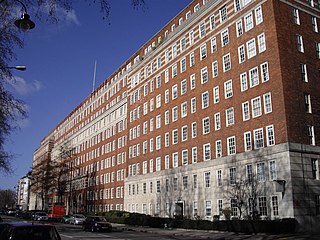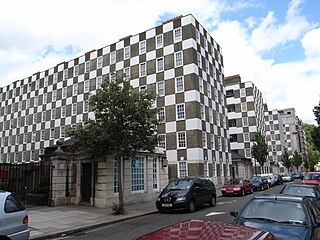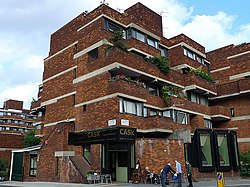
Sir Charles BarryFRS RA was a British architect, best known for his role in the rebuilding of the Palace of Westminster in London during the mid-19th century, but also responsible for numerous other buildings and gardens. He is known for his major contribution to the use of Italianate architecture in Britain, especially the use of the Palazzo as basis for the design of country houses, city mansions and public buildings. He also developed the Italian Renaissance garden style for the many gardens he designed around country houses.

Pimlico is an area of Central London in the City of Westminster, built as a southern extension to neighbouring Belgravia. It is known for its garden squares and distinctive Regency architecture. Pimlico is demarcated to the north by Victoria Station, by the River Thames to the south, Vauxhall Bridge Road to the east and the former Grosvenor Canal to the west. At its heart is a grid of residential streets laid down by the planner Thomas Cubitt, beginning in 1825 and now protected as the Pimlico Conservation Area. The most prestigious are those on garden squares, with buildings decreasing in grandeur away from St George's Square, Warwick Square, Eccleston Square and the main thoroughfares of Belgrave Road and St. George's Drive. Additions have included the pre–World War II Dolphin Square and the Churchill Gardens and Lillington and Longmoore Gardens estates, now conservation areas in their own right. The area has over 350 Grade II listed buildings and several Grade II* listed churches. At the western edge of Pimlico, on the borders of Chelsea, Pimlico Road has become known in recent years for its interiors and design stores.

The Metropolitan Borough of St Marylebone was a metropolitan borough of the County of London from 1900 to 1965. It was based directly on the previously existing civil parish of St Marylebone, Middlesex, which was incorporated into the Metropolitan Board of Works area in 1855, retaining a parish vestry, and then became part of the County of London in 1889.

Dolphin Square is an estate of private flats with some ground floor business units near the River Thames in Pimlico, Westminster, London built between 1935 and 1937. Until the building of Highbury Square, it was the most developed garden square in London built as private housing. At one time, it was home to more than 70 MPs and at least 10 Lords.

The Holly Lodge Estate is a housing estate in Highgate, north London.

The Hallfield Estate, owned by Westminster City Council, is one of several modernist housing projects in Bayswater, London designed in the immediate postwar period by the Tecton architecture practice, led by Berthold Lubetkin. Following the dissolution of Tecton, the project was realised by Denys Lasdun and Lindsay Drake in the 1950s. Construction took place in two phases during 1951–55 and 1955–58.

Churchill Gardens is a large housing estate in the Pimlico area of Westminster, London. The estate was developed between 1946 and 1962 to a design by the architects Powell and Moya, replacing Victorian terraced houses extensively damaged during the Blitz.

St James the Less is a Church of England parish church in Pimlico, Westminster, built in 1858–61 by George Edmund Street in the Gothic Revival style. A Grade I listed building, it has been described as "one of the finest Gothic Revival churches anywhere". The church was constructed predominantly in brick with embellishments from other types of stone. Its most prominent external feature is its free-standing Italian-style tower, while its interior incorporates design themes which Street observed in medieval Gothic buildings in continental Europe.

Darbourne & Darke was a firm of architects and landscape planners. Though their work includes a football stand, laboratories and offices, and the landscaping (1976–77) of much of Heathrow Airport, London, the firm's most notable output was in the realm of public housing.
George Topham Forrest, F.R.I.B.A. FGS FRSE was a Scottish architect who became chief architect for the London County Council and was responsible for the design of many public housing estates, and also co-designed two bridges over the River Thames.

The Ossulston Estate is a multi-storey council estate built by the London County Council on Chalton Street in Somers Town between 1927 and 1931. It was unusual at the time both in its inner-city location and in its modernist design, and all the original parts of the estate are now Grade II listed buildings.

Spa Green Estate between Rosebery Avenue and St John St in Clerkenwell, London EC1, England, is the most complete post-war realisation of a 1930s radical plan for social regeneration through Modernist architecture. Conceived as public housing, it is now a mixed community of private owners and council tenants, run by a resident-elected management organization. In 1998 this work by the architect Berthold Lubetkin received a Grade II* listing for its architectural significance, and the major 2008 restoration brought back the original colour scheme, which recalls Lubetkin's contacts with Russian Constructivism.

CityWest Homes was an arm's length management organisation (ALMO) of Westminster City Council, London, England, established in April 2002 in order to manage its housing stock. They managed over 21,000 properties which included council tenant and leaseholder homes in the London borough of Westminster and elsewhere. In the City of Westminster, there are the following estates:

The Old Oak and Wormholt estates are London County Council cottage estates constructed between 1912 and 1928. They were declared a conservation area in May 1980. The two estates were influenced by Ebenezer Howard's Garden city movement and the Arts and Crafts movement, which high quality external detailing and an open setting with privet hedges, front gardens and wide grass verges.

Page Street is a street in Pimlico, in the City of Westminster, that runs from Regency Street in the west to the junction of John Islip Street and Dean Ryle Street in the east, parallel with Horseferry Road. It is crossed midway by Marsham Street.

The Brandon Estate is a social housing estate in Walworth, London Borough of Southwark, south London. Situated to the south of Kennington Park, it was built in 1958 by the London County Council, to designs by Edward Hollamby and Roger Westman.

The Roman Catholic Church of St Teresa of Lisieux in Taunton, Somerset, England, dates from 1958–1959. It is the only known church design of Eric Francis, a Chepstow-born architect who worked mainly in Monmouthshire and the South-West of England. St Teresa's is a functioning parish church within the Roman Catholic Diocese of Clifton, and a Grade II listed building.

















